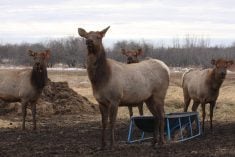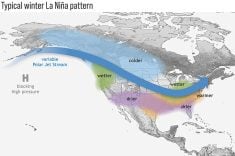Many beef producers are using cereal greenfeed as the main forage in
their winter feeding program.
If cut in the soft-dough stage or earlier, greenfeed has good levels of
crude protein and energy and satisfies the requirements of many rations.
During the last few years, however, an increasing number of cattle
herds are exhibiting problems with tetany and, in some cases, milk
fever.
It is becoming apparent that the cause is high levels of potassium that
Read Also

Saskatchewan throne speech promises strong economy
Saskatchewan’s legislative agenda for the coming year will focus on meeting the challenges of new world trading relationships, said the speech from the throne.
may be present in many cereal forages used for greenfeed or silage,
said Bryan Doig, livestock agrologist with Saskatchewan Agriculture in
North Battleford.
“The level of potassium in greenfeeds normally ranges from 1.5 to 1.9
percent on a 100 percent dry matter basis, but feed tests from cereal
forages grown in 2001 have indicated potassium levels as high as 4.2
percent,” he said.
“These same forages tend to have low levels of calcium and magnesium,
and the potential for the occurrence of tetany is calculated according
to the ratio of these three elements: the total daily intake of
potassium divided by the sum of calcium and magnesium. A value of 2.2
or higher indicates that tetany might occur.”
Doig said dry growing conditions and regions of acidic soils
contribute to potassium accumulation in plants, especially cereal
crops.
Tetany can also occur when cattle are fed poor-quality hay or straw
with low levels of magnesium.
Doig said tetany symptoms may start as nervousness, attentive ears and
flighty cows. Affected animals avoid the rest of the herd. They often
have a stiff gait and a poor appetite.
As tetany progresses, the cows may stagger and exhibit twitching on the
flanks, ears and face. They may be irritable, aggressive and lie down
and get up often.
After several days, extreme excitement and violent convulsions may
develop.
At this stage, animals lie flat on their sides with their forelegs
pedaling frequently. Saliva flows freely, breathing is laboured and the
pulse is rapid. If treatment is not administered at this stage, animals
die during or after a convulsion.
Older cows are more susceptible than first or second calvers because of
lower magnesium stores and decreased absorption efficiency.
Tetany often strikes during the last month of pregnancy or in early
stages of lactation. High-producing cows are particularly susceptible.
Dry cows and bulls are rarely affected.
“Producers may prevent tetany by ensuring their cows are receiving
adequate and balanced levels of calcium and magnesium.
“A feed analysis will indicate the levels of available nutrients and
minerals in the greenfeed or silage and, based on the results of the
feed tests, proper mineral and vitamin supplementation can then be
formulated.”
Producers should contact their veterinarian if cows exhibit signs of
tetany. Livestock nutritionists can help develop rations with proper
magnesium and calcium supplements to prevent or treat tetany problems.














